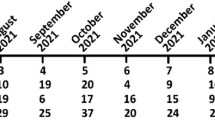Abstract
The etiology of Rotavirus in acute diarrhoeal illness in children 0–5 years of age, admitted to the pediatric wards of Kasturba Medical College Hospital, Manipal was studied over a period of 5 years. Rotavirus in the faeces detected by Latex agglutination test accounted for 19.56% of the diarrhoea with maximum incidence (65%) in the 7–12 months of age group. Bacterial aetiological agents continued to play a significant role (69.6%) in diarrhoeal diseases.Enteroaggregative E. coli was common in the age group between 25–36 months, Shigellosis in 37–60 months andSalmonella typhimurium enteritis in 7–12 months of age. The other pathogens isolated werevibrio cholerae (4.98%), species of aeromonas (15.92%), along with cryptosporidium (6.47%) and Candida albicans (3.98%). In a control group consisting of 100 children without history of diarrhoea, 2 were positive for rotavirus, 3 for cryptosporidium and 12 forEscherichia coli.
Similar content being viewed by others
References
Zhao FM, Zhao DX, Chen SDet al. Diarrhoeal disease in children less than one year of age at a children’s hospital in Guangzhou, People’s Republicof China.Trans R Soc Trop Med & Hyg 1991; 85: 667–669.
Albert MJ, Faruque M, Faruque ASet al. Controlled study ofEscherichia coli diarrhoeal infections in Bangladesh children.J Clin Microbiol 1995; 33: 973–977.
Mata L, Simhon A, Grrutia JJet al. Epidemiology of Rotaviruses in a cohort of 45 Geratemalan Mayan Indian children observed from birth to age of 3 years.J Inf Dis 1983; 148: 452–461.
Edwards PR, Ewing WH.Identification of Enterobacteriaceae, 4th edn. Minneapolis Burgess publishing Co., 1972.
Barrow GI, Feltiyham RKA. Cowan & Steel’s manual for the identification of Medical Bacteria. 3rd edn. Cambridge University Press 1974.
Hassan Namdari, Edward J. Suicide phenomenon in Mesophilic Aeromonas as a basis for species identification.J Clin Microbio 1999; 27: 788–789.
Scott AC, Colle JG, Duguid JPet al. Practical Medical Microbiology, 14th ed, vol. 2 Newyork: Churchhill Livingstone, 1991.
Mamatha Ballal, Tukaram P, Arun Cet al. Cryptosporidium and Isospora belli diarrhoea in immunocompromised hosts.Ind J Cancer 1999; 36: 38–42.
Dhia AM, Richard GF. Clinical and epidemiological characteristics of Rotavirus and EPEC associated hospitalised infantile Diarrhoea in Basrah, Iraq.J Trop Pediatr 1987; 33: 319–325.
Cuker G, Blacklow NR. Human viral gastroenteritis.Microbiol Rev 1984; 48: 157–179.
Kapikian AZ, Chanock RM. Rotavirus. In Fields BN, Knipe DM, Chanock RM, Hirsch MS, eds. Virology; 2nd edn. [Newyork, Raven press 1990: 1353–1404.
WHO, Geneva, Vaccine research & development: Rotavirus vaccines for developing countries.Weekly Epidemiol Rec 1997; 72: 35–40.
Mamatha Ballal, Shivananda PG.In vitro susceptibility of MDRS. typhimurium to newer fluoroquinolones derivatives.Ind J Pathol Microbiol 1995; 38(4): 365–368.
Mamatha Ballal, Baby, Arun C, Shivananda PG. Shigella and the fluorinated quinolones.Ind J Pathol Microbiol 1998; 41(4): 453–456.
Thirunarayana MA, Jesudasan MV, Jacob John T. Resistance of Shigella to Nalidixic acid and fluorinated quinolones.Ind J Med Res 1993; 97: 239–241.
Gurleen K, Rodrigues S, Mangala PV. A study of Aeromonas in Goa.Ind J Med Microbiol 1999; 17(4): 181–183.
Kannan S, Nair, GB. Aeromonas: An emerging pathogen associated with evolving clinical spectrum and potential determinants of pathogenicity.Ind J Med Microbiol; 2001; 8(3): 92–97.
Cobelijic MB, Miljkovic SD, Paunovic TZet al. Enteroaggregative Ecoli associated with an outbreak of diarrhoea in a neonatal nursery ward.Epidemiol Infect 1996; 117: 11–16.
James PN, James B K. Diarrhoeagenic Ecoli.Clin Microbiol Rev 1998; 1: 142–211.
Hema V, Jon ER.Diarrhoea in Rural India. A National study of mothers & practitioners, New-Delhi. UNICEF: 1990.
Author information
Authors and Affiliations
Rights and permissions
About this article
Cite this article
Ballal, M., Shivananda, P.G. Rotavirus and enteric pathogens in infantile diarrhoea in Manipal, South India. Indian J Pediatr 69, 393–396 (2002). https://doi.org/10.1007/BF02722628
Issue Date:
DOI: https://doi.org/10.1007/BF02722628



